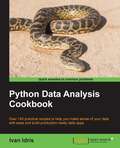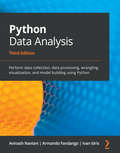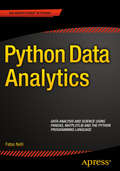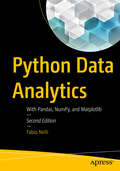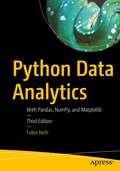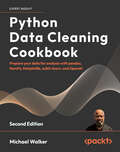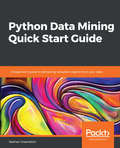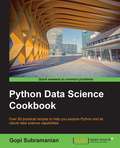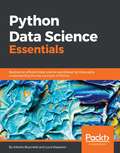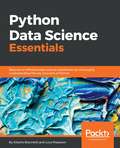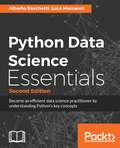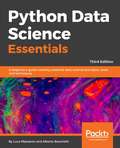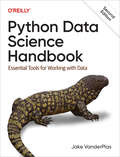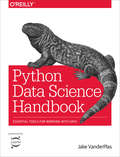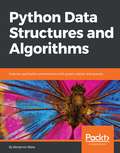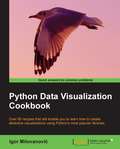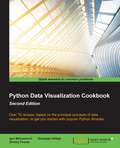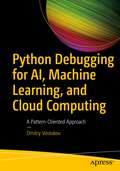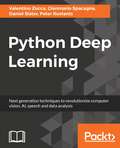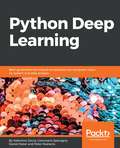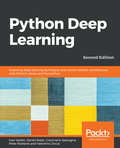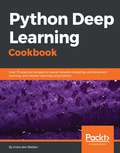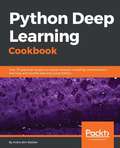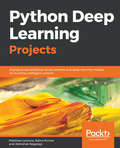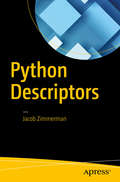- Table View
- List View
Python Data Analysis Cookbook
by Ivan IdrisOver 140 practical recipes to help you make sense of your data with ease and build production-ready data apps About This Book * Analyze Big Data sets, create attractive visualizations, and manipulate and process various data types * Packed with rich recipes to help you learn and explore amazing algorithms for statistics and machine learning * Authored by Ivan Idris, expert in python programming and proud author of eight highly reviewed books Who This Book Is For This book teaches Python data analysis at an intermediate level with the goal of transforming you from journeyman to master. Basic Python and data analysis skills and affinity are assumed. What You Will Learn * Set up reproducible data analysis * Clean and transform data * Apply advanced statistical analysis * Create attractive data visualizations * Web scrape and work with databases, Hadoop, and Spark * Analyze images and time series data * Mine text and analyze social networks * Use machine learning and evaluate the results * Take advantage of parallelism and concurrency In Detail Data analysis is a rapidly evolving field and Python is a multi-paradigm programming language suitable for object-oriented application development and functional design patterns. As Python offers a range of tools and libraries for all purposes, it has slowly evolved as the primary language for data science, including topics on: data analysis, visualization, and machine learning. Python Data Analysis Cookbook focuses on reproducibility and creating production-ready systems. You will start with recipes that set the foundation for data analysis with libraries such as matplotlib, NumPy, and pandas. You will learn to create visualizations by choosing color maps and palettes then dive into statistical data analysis using distribution algorithms and correlations. You'll then help you find your way around different data and numerical problems, get to grips with Spark and HDFS, and then set up migration scripts for web mining. In this book, you will dive deeper into recipes on spectral analysis, smoothing, and bootstrapping methods. Moving on, you will learn to rank stocks and check market efficiency, then work with metrics and clusters. You will achieve parallelism to improve system performance by using multiple threads and speeding up your code. By the end of the book, you will be capable of handling various data analysis techniques in Python and devising solutions for problem scenarios. Style and Approach The book is written in "cookbook" style striving for high realism in data analysis. Through the recipe-based format, you can read each recipe separately as required and immediately apply the knowledge gained.
Python Data Analysis: Perform data collection, data processing, wrangling, visualization, and model building using Python, 3rd Edition
by Ivan Idris Armando Fandango Avinash NavlaniUnderstand data analysis pipelines using machine learning algorithms and techniques with this practical guideKey FeaturesPrepare and clean your data to use it for exploratory analysis, data manipulation, and data wranglingDiscover supervised, unsupervised, probabilistic, and Bayesian machine learning methodsGet to grips with graph processing and sentiment analysisBook DescriptionData analysis enables you to generate value from small and big data by discovering new patterns and trends, and Python is one of the most popular tools for analyzing a wide variety of data. With this book, you'll get up and running using Python for data analysis by exploring the different phases and methodologies used in data analysis and learning how to use modern libraries from the Python ecosystem to create efficient data pipelines.Starting with the essential statistical and data analysis fundamentals using Python, you'll perform complex data analysis and modeling, data manipulation, data cleaning, and data visualization using easy-to-follow examples. You'll then understand how to conduct time series analysis and signal processing using ARMA models. As you advance, you'll get to grips with smart processing and data analytics using machine learning algorithms such as regression, classification, Principal Component Analysis (PCA), and clustering. In the concluding chapters, you'll work on real-world examples to analyze textual and image data using natural language processing (NLP) and image analytics techniques, respectively. Finally, the book will demonstrate parallel computing using Dask.By the end of this data analysis book, you'll be equipped with the skills you need to prepare data for analysis and create meaningful data visualizations for forecasting values from data.What you will learnExplore data science and its various process modelsPerform data manipulation using NumPy and pandas for aggregating, cleaning, and handling missing valuesCreate interactive visualizations using Matplotlib, Seaborn, and BokehRetrieve, process, and store data in a wide range of formatsUnderstand data preprocessing and feature engineering using pandas and scikit-learnPerform time series analysis and signal processing using sunspot cycle dataAnalyze textual data and image data to perform advanced analysisGet up to speed with parallel computing using DaskWho this book is forThis book is for data analysts, business analysts, statisticians, and data scientists looking to learn how to use Python for data analysis. Students and academic faculties will also find this book useful for learning and teaching Python data analysis using a hands-on approach. A basic understanding of math and working knowledge of the Python programming language will help you get started with this book.
Python Data Analytics
by Fabio NelliPython Data Analytics will help you tackle the world of data acquisition and analysis using the power of the Python language. At the heart of this book lies the coverage of pandas, an open source, BSD-licensed library providing high-performance, easy-to-use data structures and data analysis tools for the Python programming language. Author Fabio Nelli expertly shows the strength of the Python programming language when applied to processing, managing and retrieving information. Inside, you will see how intuitive and flexible it is to discover and communicate meaningful patterns of data using Python scripts, reporting systems, and data export. This book examines how to go about obtaining, processing, storing, managing and analyzing data using the Python programming language. You will use Python and other open source tools to wrangle data and tease out interesting and important trends in that data that will allow you to predict future patterns. Whether you are dealing with sales data, investment data (stocks, bonds, etc. ), medical data, web page usage, or any other type of data set, Python can be used to interpret, analyze, and glean information from a pile of numbers and statistics. This book is an invaluable reference with its examples of storing and accessing data in a database; it walks you through the process of report generation; it provides three real world case studies or examples that you can take with you for your everyday analysis needs. What you'll learn How to set up your environment and use automation scripts Where and how to get your data How to analyze your data with Python's data analysis library, called pandas How to carry out visualization with matplotlib How to analyze text data using Python's natural language processing Who this book is for This book is for the mid to experienced level programmer who already knows the basics of Python programming. It is for programmers who want to know how to use database data and reporting tools to manipulate raw data into coherent useful information. Table of Contents PART I 1. Setup Your Environment 2. Automation Scripts PART II 3. Where and How to Get Data 4. Introduction to pandas 5. pandas In-Depth 6. Python Data Visualizations with matplotlib 7. Designing Beautiful Graphs 8. Analyze Text Data with Natural Language Processing PART III 9. Full Example project 1 10. Full Example project 2 11. Full Example project 3 Appendix A Appendix B
Python Data Analytics: With Pandas, NumPy, and Matplotlib
by Fabio NelliExplore the latest Python tools and techniques to help you tackle the world of data acquisition and analysis. You'll review scientific computing with NumPy, visualization with matplotlib, and machine learning with scikit-learn. This revision is fully updated with new content on social media data analysis, image analysis with OpenCV, and deep learning libraries. Each chapter includes multiple examples demonstrating how to work with each library. At its heart lies the coverage of pandas, for high-performance, easy-to-use data structures and tools for data manipulationAuthor Fabio Nelli expertly demonstrates using Python for data processing, management, and information retrieval. Later chapters apply what you've learned to handwriting recognition and extending graphical capabilities with the JavaScript D3 library. Whether you are dealing with sales data, investment data, medical data, web page usage, or other data sets, Python Data Analytics, Second Edition is an invaluable reference with its examples of storing, accessing, and analyzing data.What You'll LearnUnderstand the core concepts of data analysis and the Python ecosystemGo in depth with pandas for reading, writing, and processing dataUse tools and techniques for data visualization and image analysisExamine popular deep learning libraries Keras, Theano,TensorFlow, and PyTorchWho This Book Is ForExperienced Python developers who need to learn about Pythonic tools for data analysis
Python Data Analytics: With Pandas, NumPy, and Matplotlib
by Fabio NelliExplore the latest Python tools and techniques to help you tackle the world of data acquisition and analysis. You'll review scientific computing with NumPy, visualization with matplotlib, and machine learning with scikit-learn. This third edition is fully updated for the latest version of Python and its related libraries, and includes coverage of social media data analysis, image analysis with OpenCV, and deep learning libraries. Each chapter includes multiple examples demonstrating how to work with each library. At its heart lies the coverage of pandas, for high-performance, easy-to-use data structures and tools for data manipulationAuthor Fabio Nelli expertly demonstrates using Python for data processing, management, and information retrieval. Later chapters apply what you've learned to handwriting recognition and extending graphical capabilities with the JavaScript D3 library. Whether you are dealing with sales data, investment data, medical data, web page usage, or other data sets, Python Data Analytics, Third Edition is an invaluable reference with its examples of storing, accessing, and analyzing data.What You'll LearnUnderstand the core concepts of data analysis and the Python ecosystemGo in depth with pandas for reading, writing, and processing dataUse tools and techniques for data visualization and image analysisExamine popular deep learning libraries Keras, Theano,TensorFlow, and PyTorchWho This Book Is ForExperienced Python developers who need to learn about Pythonic tools for data analysis
Python Data Cleaning Cookbook: Prepare your data for analysis with pandas, NumPy, Matplotlib, scikit-learn, and OpenAI
by Michael WalkerLearn the intricacies of data description, issue identification, and practical problem-solving, armed with essential techniques and expert tips.Key FeaturesGet to grips with new techniques for data preprocessing and cleaning for machine learning and NLP modelsUse new and updated AI tools and techniques for data cleaning tasksClean, monitor, and validate large data volumes to diagnose problems using cutting-edge methodologies including Machine learning and AIBook DescriptionJumping into data analysis without proper data cleaning will certainly lead to incorrect results. The Python Data Cleaning Cookbook - Second Edition will show you tools and techniques for cleaning and handling data with Python for better outcomes. Fully updated to the latest version of Python and all relevant tools, this book will teach you how to manipulate and clean data to get it into a useful form. he current edition focuses on advanced techniques like machine learning and AI-specific approaches and tools for data cleaning along with the conventional ones. The book also delves into tips and techniques to process and clean data for ML, AI, and NLP models. You will learn how to filter and summarize data to gain insights and better understand what makes sense and what does not, along with discovering how to operate on data to address the issues you've identified. Next, you’ll cover recipes for using supervised learning and Naive Bayes analysis to identify unexpected values and classification errors and generate visualizations for exploratory data analysis (EDA) to identify unexpected values. Finally, you’ll build functions and classes that you can reuse without modification when you have new data. By the end of this Data Cleaning book, you'll know how to clean data and diagnose problems within it.What you will learnUsing OpenAI tools for various data cleaning tasks Producing summaries of the attributes of datasets, columns, and rowsAnticipating data-cleaning issues when importing tabular data into pandasApplying validation techniques for imported tabular data Improving your productivity in pandas by using method chainingRecognizing and resolving common issues like dates and IDs Setting up indexes to streamline data issue identificationUsing data cleaning to prepare your data for ML and AI modelsWho this book is forThis book is for anyone looking for ways to handle messy, duplicate, and poor data using different Python tools and techniques. The book takes a recipe-based approach to help you to learn how to clean and manage data with practical examples. Working knowledge of Python programming is all you need to get the most out of the book.
Python Data Mining Quick Start Guide: A beginner's guide to extracting valuable insights from your data
by Nathan GreeneltchExplore the different data mining techniques using the libraries and packages offered by PythonKey FeaturesGrasp the basics of data loading, cleaning, analysis, and visualizationUse the popular Python libraries such as NumPy, pandas, matplotlib, and scikit-learn for data miningYour one-stop guide to build efficient data mining pipelines without going into too much theoryBook DescriptionData mining is a necessary and predictable response to the dawn of the information age. It is typically defined as the pattern and/ or trend discovery phase in the data mining pipeline, and Python is a popular tool for performing these tasks as it offers a wide variety of tools for data mining.This book will serve as a quick introduction to the concept of data mining and putting it to practical use with the help of popular Python packages and libraries. You will get a hands-on demonstration of working with different real-world datasets and extracting useful insights from them using popular Python libraries such as NumPy, pandas, scikit-learn, and matplotlib. You will then learn the different stages of data mining such as data loading, cleaning, analysis, and visualization. You will also get a full conceptual description of popular data transformation, clustering, and classification techniques.By the end of this book, you will be able to build an efficient data mining pipeline using Python without any hassle.What you will learnExplore the methods for summarizing datasets and visualizing/plotting dataCollect and format data for analytical workAssign data points into groups and visualize clustering patternsLearn how to predict continuous and categorical outputs for dataClean, filter noise from, and reduce the dimensions of dataSerialize a data processing model using scikit-learn’s pipeline featureDeploy the data processing model using Python’s pickle moduleWho this book is forPython developers interested in getting started with data mining will love this book. Budding data scientists and data analysts looking to quickly get to grips with practical data mining with Python will also find this book to be useful. Knowledge of Python programming is all you need to get started.
Python Data Science Cookbook
by Gopi SubramanianOver 60 practical recipes to help you explore Python and its robust data science capabilities About This Book * The book is packed with simple and concise Python code examples to effectively demonstrate advanced concepts in action * Explore concepts such as programming, data mining, data analysis, data visualization, and machine learning using Python * Get up to speed on machine learning algorithms with the help of easy-to-follow, insightful recipes Who This Book Is For This book is intended for all levels of Data Science professionals, both students and practitioners, starting from novice to experts. Novices can spend their time in the first five chapters getting themselves acquainted with Data Science. Experts can refer to the chapters starting from 6 to understand how advanced techniques are implemented using Python. People from non-Python backgrounds can also effectively use this book, but it would be helpful if you have some prior basic programming experience. What You Will Learn * Explore the complete range of Data Science algorithms * Get to know the tricks used by industry engineers to create the most accurate data science models * Manage and use Python libraries such as numpy, scipy, scikit learn, and matplotlib effectively * Create meaningful features to solve real-world problems * Take a look at Advanced Regression methods for model building and variable selection * Get a thorough understanding of the underlying concepts and implementation of Ensemble methods * Solve real-world problems using a variety of different datasets from numerical and text data modalities * Get accustomed to modern state-of-the art algorithms such as Gradient Boosting, Random Forest, Rotation Forest, and so on In Detail Python is increasingly becoming the language for data science. It is overtaking R in terms of adoption, it is widely known by many developers, and has a strong set of libraries such as Numpy, Pandas, scikit-learn, Matplotlib, Ipython and Scipy, to support its usage in this field. Data Science is the emerging new hot tech field, which is an amalgamation of different disciplines including statistics, machine learning, and computer science. It's a disruptive technology changing the face of today's business and altering the economy of various verticals including retail, manufacturing, online ventures, and hospitality, to name a few, in a big way. This book will walk you through the various steps, starting from simple to the most complex algorithms available in the Data Science arsenal, to effectively mine data and derive intelligence from it. At every step, we provide simple and efficient Python recipes that will not only show you how to implement these algorithms, but also clarify the underlying concept thoroughly. The book begins by introducing you to using Python for Data Science, followed by working with Python environments. You will then learn how to analyse your data with Python. The book then teaches you the concepts of data mining followed by an extensive coverage of machine learning methods. It introduces you to a number of Python libraries available to help implement machine learning and data mining routines effectively. It also covers the principles of shrinkage, ensemble methods, random forest, rotation forest, and extreme trees, which are a must-have for any successful Data Science Professional. Style and approach This is a step-by-step recipe-based approach to Data Science algorithms, introducing the math philosophy behind these algorithms.
Python Data Science Essentials
by Alberto Boschetti Luca MassaronIf you are an aspiring data scientist and you have at least a working knowledge of data analysis and Python, this book will get you started in data science. Data analysts with experience of R or MATLAB will also find the book to be a comprehensive reference to enhance their data manipulation and machine learning skills.
Python Data Science Essentials
by Alberto Boschetti Luca MassaronBecome an efficient data science practitioner by understanding Python's key concepts About This Book Quickly get familiar with data science using Python 3.5 Save time (and effort) with all the essential tools explained Create effective data science projects and avoid common pitfalls with the help of examples and hints dictated by experience Who This Book Is For If you are an aspiring data scientist and you have at least a working knowledge of data analysis and Python, this book will get you started in data science. Data analysts with experience of R or MATLAB will also find the book to be a comprehensive reference to enhance their data manipulation and machine learning skills. What You Will Learn Set up your data science toolbox using a Python scientific environment on Windows, Mac, and Linux Get data ready for your data science project Manipulate, fix, and explore data in order to solve data science problems Set up an experimental pipeline to test your data science hypotheses Choose the most effective and scalable learning algorithm for your data science tasks Optimize your machine learning models to get the best performance Explore and cluster graphs, taking advantage of interconnections and links in your data In Detail Fully expanded and upgraded, the second edition of Python Data Science Essentials takes you through all you need to know to suceed in data science using Python. Get modern insight into the core of Python data, including the latest versions of Jupyter notebooks, NumPy, pandas and scikit-learn. Look beyond the fundamentals with beautiful data visualizations with Seaborn and ggplot, web development with Bottle, and even the new frontiers of deep learning with Theano and TensorFlow. Dive into building your essential Python 3.5 data science toolbox, using a single-source approach that will allow to to work with Python 2.7 as well. Get to grips fast with data munging and preprocessing, and all the techniques you need to load, analyse, and process your data. Finally, get a complete overview of principal machine learning algorithms, graph analysis techniques, and all the visualization and deployment instruments that make it easier to present your results to an audience of both data science experts and business users. Style and approach The book is structured as a data science project. You will always benefit from clear code and simplified examples to help you understand the underlying mechanics and real-world datasets.
Python Data Science Essentials - Second Edition
by Alberto Boschetti Luca MassaronBecome an efficient data science practitioner by understanding Python's key concepts About This Book * Quickly get familiar with data science using Python 3.5 * Save time (and effort) with all the essential tools explained * Create effective data science projects and avoid common pitfalls with the help of examples and hints dictated by experience Who This Book Is For If you are an aspiring data scientist and you have at least a working knowledge of data analysis and Python, this book will get you started in data science. Data analysts with experience of R or MATLAB will also find the book to be a comprehensive reference to enhance their data manipulation and machine learning skills. What You Will Learn * Set up your data science toolbox using a Python scientific environment on Windows, Mac, and Linux * Get data ready for your data science project * Manipulate, fix, and explore data in order to solve data science problems * Set up an experimental pipeline to test your data science hypotheses * Choose the most effective and scalable learning algorithm for your data science tasks * Optimize your machine learning models to get the best performance * Explore and cluster graphs, taking advantage of interconnections and links in your data In Detail Fully expanded and upgraded, the second edition of Python Data Science Essentials takes you through all you need to know to suceed in data science using Python. Get modern insight into the core of Python data, including the latest versions of Jupyter notebooks, NumPy, pandas and scikit-learn. Look beyond the fundamentals with beautiful data visualizations with Seaborn and ggplot, web development with Bottle, and even the new frontiers of deep learning with Theano and TensorFlow. Dive into building your essential Python 3.5 data science toolbox, using a single-source approach that will allow to to work with Python 2.7 as well. Get to grips fast with data munging and preprocessing, and all the techniques you need to load, analyse, and process your data. Finally, get a complete overview of principal machine learning algorithms, graph analysis techniques, and all the visualization and deployment instruments that make it easier to present your results to an audience of both data science experts and business users. Style and approach The book is structured as a data science project. You will always benefit from clear code and simplified examples to help you understand the underlying mechanics and real-world datasets.
Python Data Science Essentials: A practitioner’s guide covering essential data science principles, tools, and techniques, 3rd Edition
by Alberto Boschetti Luca MassaronGain useful insights from your data using popular data science toolsKey FeaturesA one-stop guide to Python libraries such as pandas and NumPyComprehensive coverage of data science operations such as data cleaning and data manipulationChoose scalable learning algorithms for your data science tasksBook DescriptionFully expanded and upgraded, the latest edition of Python Data Science Essentials will help you succeed in data science operations using the most common Python libraries. This book offers up-to-date insight into the core of Python, including the latest versions of the Jupyter Notebook, NumPy, pandas, and scikit-learn.The book covers detailed examples and large hybrid datasets to help you grasp essential statistical techniques for data collection, data munging and analysis, visualization, and reporting activities. You will also gain an understanding of advanced data science topics such as machine learning algorithms, distributed computing, tuning predictive models, and natural language processing. Furthermore, You’ll also be introduced to deep learning and gradient boosting solutions such as XGBoost, LightGBM, and CatBoost.By the end of the book, you will have gained a complete overview of the principal machine learning algorithms, graph analysis techniques, and all the visualization and deployment instruments that make it easier to present your results to an audience of both data science experts and business usersWhat you will learnSet up your data science toolbox on Windows, Mac, and LinuxUse the core machine learning methods offered by the scikit-learn libraryManipulate, fix, and explore data to solve data science problemsLearn advanced explorative and manipulative techniques to solve data operationsOptimize your machine learning models for optimized performanceExplore and cluster graphs, taking advantage of interconnections and links in your dataWho this book is forIf you’re a data science entrant, data analyst, or data engineer, this book will help you get ready to tackle real-world data science problems without wasting any time. Basic knowledge of probability/statistics and Python coding experience will assist you in understanding the concepts covered in this book.
Python Data Science Handbook: Essential Tools for Working with Data
by Jake VanderPlasPython is a first-class tool for many researchers, primarily because of its libraries for storing, manipulating, and gaining insight from data. Several resources exist for individual pieces of this data science stack, but only with the new edition of Python Data Science Handbook do you get them all--IPython, NumPy, pandas, Matplotlib, scikit-learn, and other related tools.Working scientists and data crunchers familiar with reading and writing Python code will find the second edition of this comprehensive desk reference ideal for tackling day-to-day issues: manipulating, transforming, and cleaning data; visualizing different types of data; and using data to build statistical or machine learning models. Quite simply, this is the must-have reference for scientific computing in Python.With this handbook, you'll learn how:IPython and Jupyter provide computational environments for scientists using PythonNumPy includes the ndarray for efficient storage and manipulation of dense data arraysPandas contains the DataFrame for efficient storage and manipulation of labeled/columnar dataMatplotlib includes capabilities for a flexible range of data visualizationsScikit-learn helps you build efficient and clean Python implementations of the most important and established machine learning algorithms
Python Data Science Handbook: Essential Tools for Working with Data
by Jake VanderplasFor many researchers, Python is a first-class tool mainly because of its libraries for storing, manipulating, and gaining insight from data. Several resources exist for individual pieces of this data science stack, but only with the Python Data Science Handbook do you get them all--IPython, NumPy, Pandas, Matplotlib, Scikit-Learn, and other related tools.Working scientists and data crunchers familiar with reading and writing Python code will find this comprehensive desk reference ideal for tackling day-to-day issues: manipulating, transforming, and cleaning data; visualizing different types of data; and using data to build statistical or machine learning models. Quite simply, this is the must-have reference for scientific computing in Python.With this handbook, you'll learn how to use:IPython and Jupyter: provide computational environments for data scientists using PythonNumPy: includes the ndarray for efficient storage and manipulation of dense data arrays in PythonPandas: features the DataFrame for efficient storage and manipulation of labeled/columnar data in PythonMatplotlib: includes capabilities for a flexible range of data visualizations in PythonScikit-Learn: for efficient and clean Python implementations of the most important and established machine learning algorithms
Python Data Structures and Algorithms: Write Complex And Powerful Code Using The Latest Features Of Python 3. 7, 2nd Edition
by Benjamin BakaImplement classic and functional data structures and algorithms using Python About This Book • A step by step guide, which will provide you with a thorough discussion on the analysis and design of fundamental Python data structures. • Get a better understanding of advanced Python concepts such as big-o notation, dynamic programming, and functional data structures. • Explore illustrations to present data structures and algorithms, as well as their analysis, in a clear, visual manner. Who This Book Is For The book will appeal to Python developers. A basic knowledge of Python is expected. What You Will Learn • Gain a solid understanding of Python data structures. • Build sophisticated data applications. • Understand the common programming patterns and algorithms used in Python data science. • Write efficient robust code. In Detail Data structures allow you to organize data in a particular way efficiently. They are critical to any problem, provide a complete solution, and act like reusable code. In this book, you will learn the essential Python data structures and the most common algorithms. With this easy-to-read book, you will be able to understand the power of linked lists, double linked lists, and circular linked lists. You will be able to create complex data structures such as graphs, stacks and queues. We will explore the application of binary searches and binary search trees. You will learn the common techniques and structures used in tasks such as preprocessing, modeling, and transforming data. We will also discuss how to organize your code in a manageable, consistent, and extendable way. The book will explore in detail sorting algorithms such as bubble sort, selection sort, insertion sort, and merge sort. By the end of the book, you will learn how to build components that are easy to understand, debug, and use in different applications. Style and approach The easy-to-read book with its fast-paced nature will improve the productivity of Python programmers and improve the performance of Python applications.
Python Data Visualization Cookbook
by Igor MilovanovicThis book is written in a Cookbook style targeted towards an advanced audience. It covers the advanced topics of data visualization in Python.Python Data Visualization Cookbook is for developers that already know about Python programming in general. If you have heard about data visualization but you don't know where to start, then this book will guide you from the start and help you understand data, data formats, data visualization, and how to use Python to visualize data.You will need to know some general programming concepts, and any kind of programming experience will be helpful, but the code in this book is explained almost line by line. You don't need maths for this book, every concept that is introduced is thoroughly explained in plain English, and references are available for further interest in the topic.
Python Data Visualization Cookbook - Second Edition
by Igor Milovanovic Giuseppe Vettigli Dimitry FouresOver 70 recipes to get you started with popular Python libraries based on the principal concepts of data visualization About This Book * Learn how to set up an optimal Python environment for data visualization * Understand how to import, clean and organize your data * Determine different approaches to data visualization and how to choose the most appropriate for your needs Who This Book Is For If you already know about Python programming and want to understand data, data formats, data visualization, and how to use Python to visualize data then this book is for you. What You Will Learn * Introduce yourself to the essential tooling to set up your working environment * Explore your data using the capabilities of standard Python Data Library and Panda Library * Draw your first chart and customize it * Use the most popular data visualization Python libraries * Make 3D visualizations mainly using mplot3d * Create charts with images and maps * Understand the most appropriate charts to describe your data * Know the matplotlib hidden gems * Use plot.ly to share your visualization online In Detail Python Data Visualization Cookbook will progress the reader from the point of installing and setting up a Python environment for data manipulation and visualization all the way to 3D animations using Python libraries. Readers will benefit from over 60 precise and reproducible recipes that will guide the reader towards a better understanding of data concepts and the building blocks for subsequent and sometimes more advanced concepts. Python Data Visualization Cookbook starts by showing how to set up matplotlib and the related libraries that are required for most parts of the book, before moving on to discuss some of the lesser-used diagrams and charts such as Gantt Charts or Sankey diagrams. Initially it uses simple plots and charts to more advanced ones, to make it easy to understand for readers. As the readers will go through the book, they will get to know about the 3D diagrams and animations. Maps are irreplaceable for displaying geo-spatial data, so this book will also show how to build them. In the last chapter, it includes explanation on how to incorporate matplotlib into different environments, such as a writing system, LaTeX, or how to create Gantt charts using Python. Style and approach A step-by-step recipe based approach to data visualization. The topics are explained sequentially as cookbook recipes consisting of a code snippet and the resulting visualization.
Python Debugging for AI, Machine Learning, and Cloud Computing: A Pattern-Oriented Approach
by Dmitry VostokovThis book is for those who wish to understand how Python debugging is and can be used to develop robust and reliable AI, machine learning, and cloud computing software. It will teach you a novel pattern-oriented approach to diagnose and debug abnormal software structure and behavior. The book begins with an introduction to the pattern-oriented software diagnostics and debugging process that, before performing Python debugging, diagnoses problems in various software artifacts such as memory dumps, traces, and logs. Next, you’ll learn to use various debugging patterns through Python case studies that model abnormal software behavior. You’ll also be exposed to Python debugging techniques specific to cloud native and machine learning environments and explore how recent advances in AI/ML can help in Python debugging. Over the course of the book, case studies will show you how to resolve issues around environmental problems, crashes, hangs, resource spikes, leaks, and performance degradation. This includes tracing, logging, and analyziing memory dumps using native WinDbg and GDB debuggers. Upon completing this book, you will have the knowledge and tools needed to employ Python debugging in the development of AI, machine learning, and cloud computing applications. What You Will Learn Employ a pattern-oriented approach to Python debugging that starts with diagnostics of common software problemsUse tips and tricks to get the most out of popular IDEs, notebooks, and command-line Python debuggingUnderstand Python internals for interfacing with operating systems and external modulesPerform Python memory dump analysis, tracing, and logging Who This Book Is For Software developers, AI/ML engineers, researchers, data engineers, as well as MLOps and DevOps professionals.
Python Deep Learning
by Daniel Slater Gianmario Spacagna Peter Roelants Valentino ZoccaTake your machine learning skills to the next level by mastering Deep Learning concepts and algorithms using Python. About This Book • Explore and create intelligent systems using cutting-edge deep learning techniques • Implement deep learning algorithms and work with revolutionary libraries in Python • Get real-world examples and easy-to-follow tutorials on Theano, TensorFlow, H2O and more Who This Book Is For This book is for Data Science practitioners as well as aspirants who have a basic foundational understanding of Machine Learning concepts and some programming experience with Python. A mathematical background with a conceptual understanding of calculus and statistics is also desired. What You Will Learn • Get a practical deep dive into deep learning algorithms • Explore deep learning further with Theano, Caffe, Keras, and TensorFlow • Learn about two of the most powerful techniques at the core of many practical deep learning implementations: Auto-Encoders and Restricted Boltzmann Machines • Dive into Deep Belief Nets and Deep Neural Networks • Discover more deep learning algorithms with Dropout and Convolutional Neural Networks • Get to know device strategies so you can use deep learning algorithms and libraries in the real world In Detail With an increasing interest in AI around the world, deep learning has attracted a great deal of public attention. Every day, deep learning algorithms are used broadly across different industries. The book will give you all the practical information available on the subject, including the best practices, using real-world use cases. You will learn to recognize and extract information to increase predictive accuracy and optimize results. Starting with a quick recap of important machine learning concepts, the book will delve straight into deep learning principles using Sci-kit learn. Moving ahead, you will learn to use the latest open source libraries such as Theano, Keras, Google's TensorFlow, and H20. Use this guide to uncover the difficulties of pattern recognition, scaling data with greater accuracy and discussing deep learning algorithms and techniques. Whether you want to dive deeper into Deep Learning, or want to investigate how to get more out of this powerful technology, you'll find everything inside. Style and approach Python Machine Learning by example follows practical hands on approach. It walks you through the key elements of Python and its powerful machine learning libraries with the help of real world projects.
Python Deep Learning
by Daniel Slater Gianmario Spacagna Peter Roelants Valentino ZoccaTake your machine learning skills to the next level by mastering Deep Learning concepts and algorithms using Python. About This Book Explore and create intelligent systems using cutting-edge deep learning techniques Implement deep learning algorithms and work with revolutionary libraries in Python Get real-world examples and easy-to-follow tutorials on Theano, TensorFlow, H2O and more Who This Book Is For This book is for Data Science practitioners as well as aspirants who have a basic foundational understanding of Machine Learning concepts and some programming experience with Python. A mathematical background with a conceptual understanding of calculus and statistics is also desired. What You Will Learn Get a practical deep dive into deep learning algorithms Explore deep learning further with Theano, Caffe, Keras, and TensorFlow Learn about two of the most powerful techniques at the core of many practical deep learning implementations: Auto-Encoders and Restricted Boltzmann Machines Dive into Deep Belief Nets and Deep Neural Networks Discover more deep learning algorithms with Dropout and Convolutional Neural Networks Get to know device strategies so you can use deep learning algorithms and libraries in the real world In Detail With an increasing interest in AI around the world, deep learning has attracted a great deal of public attention. Every day, deep learning algorithms are used broadly across different industries. The book will give you all the practical information available on the subject, including the best practices, using real-world use cases. You will learn to recognize and extract information to increase predictive accuracy and optimize results. Starting with a quick recap of important machine learning concepts, the book will delve straight into deep learning principles using Sci-kit learn. Moving ahead, you will learn to use the latest open source libraries such as Theano, Keras, Google's TensorFlow, and H20. Use this guide to uncover the difficulties of pattern recognition, scaling data with greater accuracy and discussing deep learning algorithms and techniques. Whether you want to dive deeper into Deep Learning, or want to investigate how to get more out of this powerful technology, you'll find everything inside. Style and approach Python Machine Learning by example follows practical hands on approach. It walks you through the key elements of Python and its powerful machine learning libraries with the help of real world projects.
Python Deep Learning - Second Edition: Exploring deep learning techniques and neural network architectures with PyTorch, Keras, and TensorFlow, 2nd Edition
by Daniel Slater Gianmario Spacagna Peter Roelants Valentino Zocca Ivan VasilevThis book is for Data Science practitioners, Machine Learning Engineers and Deep learning aspirants who have a basic foundation of Machine Learning concepts and some programming experience with Python. A mathematical background with a conceptual understanding of calculus and statistics is also desired
Python Deep Learning Cookbook
by Indra Den BakkerSolve different problems in modelling deep neural networks using Python, Tensorflow, and Keras with this practical guide About This Book • Practical recipes on training different neural network models and tuning them for optimal performance • Use Python frameworks like TensorFlow, Caffe, Keras, Theano for Natural Language Processing, Computer Vision, and more • A hands-on guide covering the common as well as the not so common problems in deep learning using Python Who This Book Is For This book is intended for machine learning professionals who are looking to use deep learning algorithms to create real-world applications using Python. Thorough understanding of the machine learning concepts and Python libraries such as NumPy, SciPy and scikit-learn is expected. Additionally, basic knowledge in linear algebra and calculus is desired. What You Will Learn • Implement different neural network models in Python • Select the best Python framework for deep learning such as PyTorch, Tensorflow, MXNet and Keras • Apply tips and tricks related to neural networks internals, to boost learning performances • Consolidate machine learning principles and apply them in the deep learning field • Reuse and adapt Python code snippets to everyday problems • Evaluate the cost/benefits and performance implication of each discussed solution In Detail Deep Learning is revolutionizing a wide range of industries. For many applications, deep learning has proven to outperform humans by making faster and more accurate predictions. This book provides a top-down and bottom-up approach to demonstrate deep learning solutions to real-world problems in different areas. These applications include Computer Vision, Natural Language Processing, Time Series, and Robotics. The Python Deep Learning Cookbook presents technical solutions to the issues presented, along with a detailed explanation of the solutions. Furthermore, a discussion on corresponding pros and cons of implementing the proposed solution using one of the popular frameworks like TensorFlow, PyTorch, Keras and CNTK is provided. The book includes recipes that are related to the basic concepts of neural networks. All techniques s, as well as classical networks topologies. The main purpose of this book is to provide Python programmers a detailed list of recipes to apply deep learning to common and not-so-common scenarios. Style and approach Unique blend of independent recipes arranged in the most logical manner
Python Deep Learning Cookbook
by Indra Den BakkerSolve different problems in modelling deep neural networks using Python, Tensorflow, and Keras with this practical guide About This Book Practical recipes on training different neural network models and tuning them for optimal performance Use Python frameworks like TensorFlow, Caffe, Keras, Theano for Natural Language Processing, Computer Vision, and more A hands-on guide covering the common as well as the not so common problems in deep learning using Python Who This Book Is For This book is intended for machine learning professionals who are looking to use deep learning algorithms to create real-world applications using Python. Thorough understanding of the machine learning concepts and Python libraries such as NumPy, SciPy and scikit-learn is expected. Additionally, basic knowledge in linear algebra and calculus is desired. What You Will Learn Implement different neural network models in Python Select the best Python framework for deep learning such as PyTorch, Tensorflow, MXNet and Keras Apply tips and tricks related to neural networks internals, to boost learning performances Consolidate machine learning principles and apply them in the deep learning field Reuse and adapt Python code snippets to everyday problems Evaluate the cost/benefits and performance implication of each discussed solution In Detail Deep Learning is revolutionizing a wide range of industries. For many applications, deep learning has proven to outperform humans by making faster and more accurate predictions. This book provides a top-down and bottom-up approach to demonstrate deep learning solutions to real-world problems in different areas. These applications include Computer Vision, Natural Language Processing, Time Series, and Robotics. The Python Deep Learning Cookbook presents technical solutions to the issues presented, along with a detailed explanation of the solutions. Furthermore, a discussion on corresponding pros and cons of implementing the proposed solution using one of the popular frameworks like TensorFlow, PyTorch, Keras and CNTK is provided. The book includes recipes that are related to the basic concepts of neural networks. All techniques s, as well as classical networks topologies. The main purpose of this book is to provide Python programmers a detailed list of recipes to apply deep learning to common and not-so-common scenarios. Style and approach Unique blend of independent recipes arranged in the most logical manner
Python Deep Learning Projects: 9 projects demystifying neural network and deep learning models for building intelligent systems
by Matthew Lamons Rahul Kumar Abhishek NagarajaInsightful projects to master deep learning and neural network architectures using Python and KerasKey FeaturesExplore deep learning across computer vision, natural language processing (NLP), and image processingDiscover best practices for the training of deep neural networks and their deploymentAccess popular deep learning models as well as widely used neural network architecturesBook DescriptionDeep learning has been gradually revolutionizing every field of artificial intelligence, making application development easier.Python Deep Learning Projects imparts all the knowledge needed to implement complex deep learning projects in the field of computational linguistics and computer vision. Each of these projects is unique, helping you progressively master the subject. You’ll learn how to implement a text classifier system using a recurrent neural network (RNN) model and optimize it to understand the shortcomings you might experience while implementing a simple deep learning system.Similarly, you’ll discover how to develop various projects, including word vector representation, open domain question answering, and building chatbots using seq-to-seq models and language modeling. In addition to this, you’ll cover advanced concepts, such as regularization, gradient clipping, gradient normalization, and bidirectional RNNs, through a series of engaging projects.By the end of this book, you will have gained knowledge to develop your own deep learning systems in a straightforward way and in an efficient wayWhat you will learnSet up a deep learning development environment on Amazon Web Services (AWS)Apply GPU-powered instances as well as the deep learning AMIImplement seq-to-seq networks for modeling natural language processing (NLP)Develop an end-to-end speech recognition systemBuild a system for pixel-wise semantic labeling of an imageCreate a system that generates images and their regionsWho this book is forPython Deep Learning Projects is for you if you want to get insights into deep learning, data science, and artificial intelligence. This book is also for those who want to break into deep learning and develop their own AI projects.It is assumed that you have sound knowledge of Python programming
Python Descriptors
by Jacob ZimmermanThis short book on Python descriptors is a collection of knowledge and ideas from many sources on dealing with and creating descriptors. And, after going through the things all descriptors have in common, the author explores ideas that have multiple ways of being implemented as well as completely new ideas never seen elsewhere before. This truly is a comprehensive guide to creating Python descriptors. As a bonus: A pip install-able library, descriptor_tools, was written alongside this book and is an open source library on GitHub. There aren't many good resources out there for writing Python descriptors, and extremely few books. This is a sad state of affairs, as it makes it difficult for Python developers to get a really good understanding of how descriptors work and the techniques to avoid the big gotchas associated with working with them. What You Will Learn Discover descriptor protocols Master attribute access and how it applies to descriptors Make descriptors and discover why you should Store attributes Create read-only descriptors and _delete() Explore the descriptor classes Apply the other uses of descriptors and more Who This Book Is For Experienced Python coders, programmers and developers.
